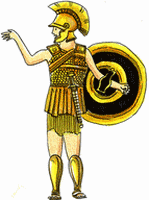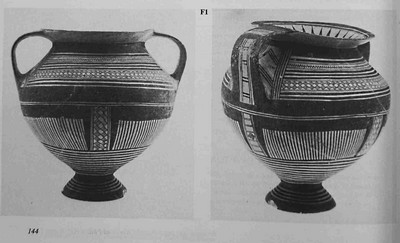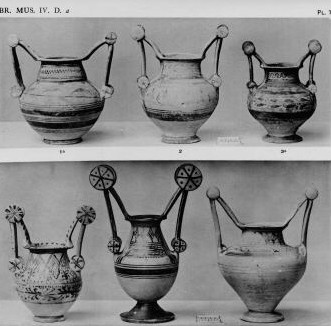Maps of the Antique
Mediterranean Sea
 Greece Greece
 Attic Attic
 Corinth Corinth
 Magna Graecia Magna Graecia
 Apulia Apulia
 Daunia Daunia
 Some dates Some dates
 Archaeological sites Archaeological sites
 Pottery and ceramics Pottery and ceramics
 Gnathia Gnathia
 Campania Campania

|
DAUNIAN POTTERY AND CERAMICS
The characteristic shapes of Daunian pottery do not seem inspired by Greece, but rather by the Bronze Age, with a continuous evolution from prehistory to antiquity. This would suggest that Daunia remained for a long time attached deeply to its traditions, whereas some apulian productions will soon become so close to the attics models for example, that it is sometimes difficult to distinguish between them.
At the end of the Bronze Age, a new kind of ceramics, inspired from the mycenian imported pottery, appears in Southern Italy. Made from purified clay, the vases are elaborated on a slow potter wheel. Their decoration consists in geometrical and vegetal patterns. It is remarkably homogeneous, but at the end of the 9th century B.C. appear the first signs of an ethnic differentiation.
 Peucetien crater, middle of the 6th century. B.C. found in Bari Peucetien crater, middle of the 6th century. B.C. found in Bari
In Peucetia, the most remarkable ceramic shape is a kind of crater, having different types of handles, resting sometimes on an high foot. The drawings is devided into separate sections, less geometric than on daunien pottery, but with a more repetitive rhythm of the geometric patterns.
The daunian ceramics are the most common, and easy to recognize owing to its dense and dark polychromy, and its rigorous drawing. Its summit lies between 550 and 400 B.C. The most typical shape is the jug with a high handle touching the lip (attingitoio, kind of ladle similar to the Greek kyathos), the vessel looking like a goatskin flask (askos in Greek) and a vessel provided with a filter.
Daunian kyathos, 4th century B.C., probably from Ascoli

The messapian style is characterized by different shapes among which a vessel with high handles - in Italian olla – who dominated in in all the peninsula of Salento. Modified by the addition of wheels applied to the handles, it is named « trozzella », the archetyp of messapian vessel. Its decoration is finer, more often vegetal, the colors being perhaps less bright
Trozzella, middle 4th century B.C.

Each production workshops, numerous and scattered on all the territory, has its own specificity. The kyathos generally come from Herdonia (today Ordona) or Asklon (Ascoli Satriano), the vessels with filters are specific from Canosa.
By this time appear also zoomorphic and anthropomorphic elements in the production. By the 4th century B. C., the greek influence becomes evident and the most important daunian centers (Canosa, Ordona and Ascoli) abandon the geometric ornaments for vegetal and figurative patterns.
Steles
 Since there are no written sources to inform us about the Iapyge culture, their ceramics is difficult to interpret and specialists can only make assumptions regarding the vessel’s use. Up to recent years, these relied almost exclusively on the examination of ceramics, but excavations carried out especially in Daunia and Peucetia revealed new kinds of artifacts which clarify the artistic panorama of Apulia : hundreds of fragments of engraved and painted steles. Since there are no written sources to inform us about the Iapyge culture, their ceramics is difficult to interpret and specialists can only make assumptions regarding the vessel’s use. Up to recent years, these relied almost exclusively on the examination of ceramics, but excavations carried out especially in Daunia and Peucetia revealed new kinds of artifacts which clarify the artistic panorama of Apulia : hundreds of fragments of engraved and painted steles.
Most of these steles come from the ancient necropolis of Siponte. They are made from a rectangular local limestone slab showing, in an extremely schematized manner, the image of the deads. Other engraved scenes indicate a complex iconography and some talent for the composition, which other native Italian populations ignored. The meaning of some scenes showing offering processions or huntings (undoubtedly intended for the dead), are still mysterious for the specialists, as well as their relation to precise cultural schemes.
Unfortunately the steles were not found on the sites on which they indicated the location of the tombs, because all have been reused elsewhere. The production of the steles continued probably long enough: it may possibly have influenced other particular sculptures in Puglia.
|














 Peucetien crater, middle of the 6th century. B.C. found in Bari
Peucetien crater, middle of the 6th century. B.C. found in Bari


 Since there are no written sources to inform us about the Iapyge culture, their ceramics is difficult to interpret and specialists can only make assumptions regarding the vessel’s use. Up to recent years, these relied almost exclusively on the examination of ceramics, but excavations carried out especially in Daunia and Peucetia revealed new kinds of artifacts which clarify the artistic panorama of Apulia : hundreds of fragments of engraved and painted steles.
Since there are no written sources to inform us about the Iapyge culture, their ceramics is difficult to interpret and specialists can only make assumptions regarding the vessel’s use. Up to recent years, these relied almost exclusively on the examination of ceramics, but excavations carried out especially in Daunia and Peucetia revealed new kinds of artifacts which clarify the artistic panorama of Apulia : hundreds of fragments of engraved and painted steles.